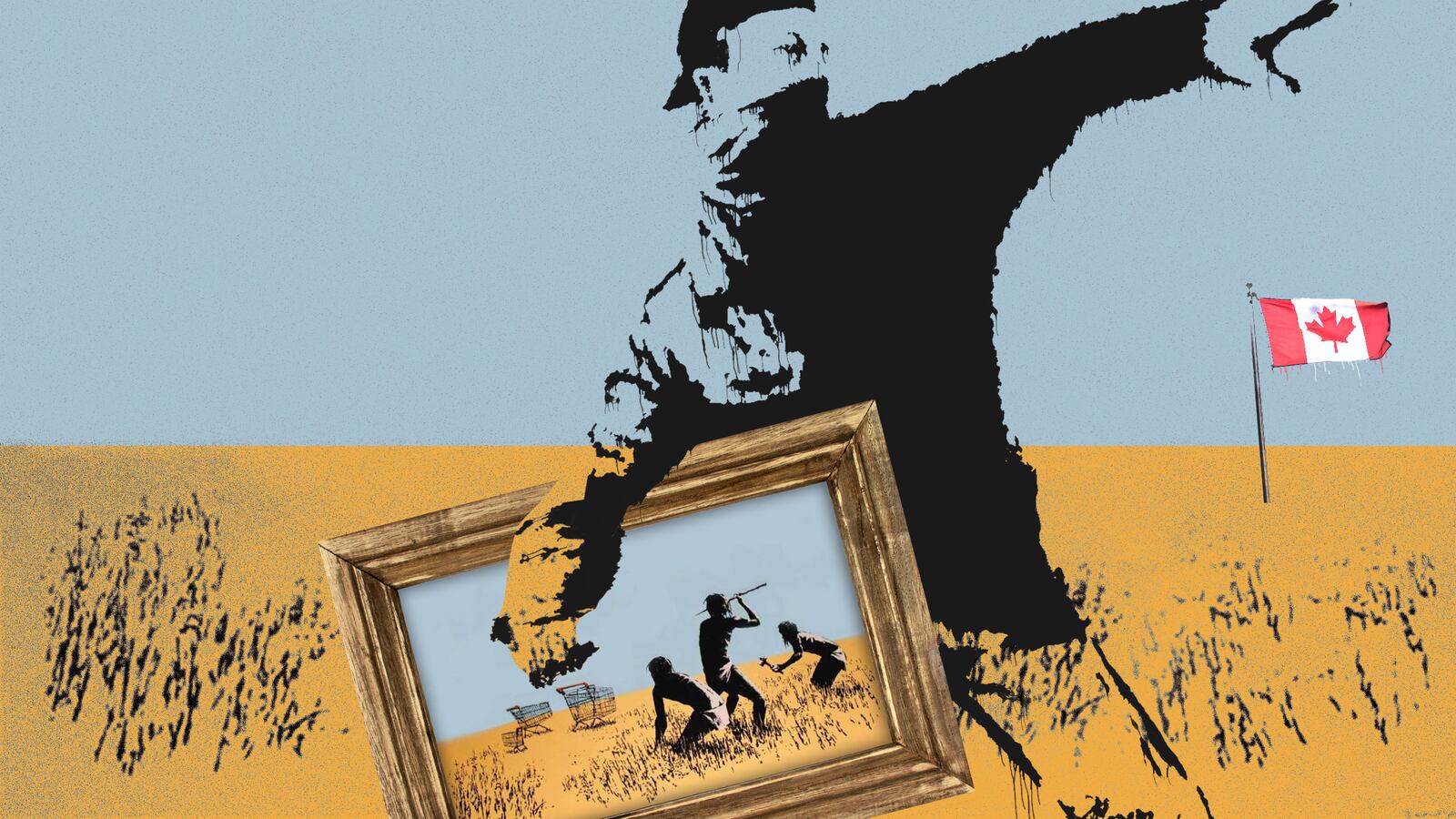The video opens on a quiet, empty warehouse-cum-gallery space.
Off to the side, a glowing “Exit” sign tops a set of double doors, the right side propped open. A few seconds after the clip begins, we see the shadow of a body in the window, hesitantly moving around on the other side of the doors.
Then, a man enters the room, his dark jacket pulled up over his face, his arms tucked under his armpits, a camouflage cap covering his head. He moves around the edge of the room in a slow side-step.
This is a thief who slinks. He employs that form of motion that provokes a little spontaneous shiver of excitement, a hint of danger, when just the name is mentioned.
It is the province of cartoons and the often-bumbling bad guys in ridiculous capers, those who have no idea that they are displaying the most suspicious form of motion perhaps ever taken. The Pink Panther is the king of slink.
So, too, it seems, is one improbably successful thief who stole a Banksy piece, “Trolley Hunters,” from a temporary gallery space in Toronto on Sunday, June 10 at 5:04 in the morning. After grabbing the print, frame and all, off the wall, our man of crime slunk right on out the way he came, absconding in plain sight with the large, $35,000 piece.
The theft occurred during the installation of an unauthorized exhibition entitled The Art of Banksy that has been open for just over a week, but already has been extended through mid-August.
The show is curated by Steve Lazarides, Banksy’s former dealer, who has gathered 80 pieces by the famous—and famously anonymous—street artist in a show that touts itself as the “largest collection of Banksy works ever assembled.”
Lazarides began working with Banksy in the early days of the street artist’s career, after the then-photographer was hired by Sleaze Nation to photograph the artist. Lazarides was impressed by Banksy’s work and offered to help sell some of his prints. With that, one of the pivotal partnerships in the nascent boom of street art was born.
For just over a decade, the two worked together in what Lazarides has described as “11 years of complete and utter insanity.” During that time, Banksy was catapulted from an anonymous and relatively unknown Bristol-born street artist to an anonymous street artist of rabid international fame. Banksy’s original works—complete with their canvases of brick walls, garage doors, and all—now sell for millions of dollars, and his movements around the globe are avidly followed.
“I worked with him for 11 glorious years during which time we broke every rule in the art rule book along with a fair few laws. He has since gone on to become a global superstar and has retained his ability to shock and make people chuckle,” Lazarides writes on his gallery’s website.
And then, in 2008, the two split. Neither have discussed the specific circumstances that led to the break-up, although Lazarides told Vanity Fair in 2010 that he was ready to “branch out.”
“We haven’t really spoken to each other in a long time; to be honest, I have no idea where he is,” Lazarides told Vanity Fair, continuing on to explain, “It’s like when you’re in a relationship and people don’t define you as an individual; they define you as a couple. And it annoys him far more than it annoys me.”
But their division hasn’t stopped Lazarides from continuing to cash in on the Banksy fever. The art dealer has curated several shows of the artist’s work, including this latest iteration in Toronto, without the collaboration or authorization of the artist. It isn’t necessarily an unusual arrangement in the art world; after all, art owners are allowed to do with their purchases what they will.
Still, it may be no surprise that the unauthorized status of the exhibition initially gave rise to a theory that the “Trolley Hunter” caper was the work of the artist himself. It was no doubt a very Banksian crime. The disguise, the dramatic entrance, the statement you could read into the action of robbing an exhibition of works born out of free and public street art that now visitors are being charged over $25 USD to see.
Plus, Banksy is no stranger to playful stunts that pack a messaging punch.
In 2006, he surreptitiously entered four vaunted New York museums—the Met, the MoMA, the Brooklyn Museum, and the Museum of Natural History—while in disguise and hung a piece of his own work in each of the museums.
He escaped without a trace in each instance of what was popularly described as a “hang in run.” (When asked why he did what he did, his explanation was simple: “I thought some of [the paintings] were quite good. That's why I thought, you know, put them in a gallery. Otherwise, they would just sit at home and no one would see them.”)
He clearly has the chops to carry this scheme out, and he has the political drive to make a statement. And, of course, there’s the personal motive. There seems to be no love lost between the artist and his former dealer or the unauthorized exhibitions Lazarides continues to curate.
Ahead of the Melbourne opening of the show in 2016, Lazarides responded to a question of whether the show would “piss off” his former friend with the response "Hell yeah, I hope so. We've been at loggerheads for years.”
He took a more diplomatic approach recently when he told CBC Toronto, “In his heart of hearts, I think he'd rather have people looking at his work rather than it being mothballed in some warehouse somewhere.”
But despite the intrigue that would follow from Banksy stealing a Banksy, there is no evidence that the artist was actually the perpetrator. The parties involved in the exhibition deny that this incident was in any way a stunt. When reached for comment, Constable Jenifferjit Sidhu of the Toronto Police Department, who released the CCTV footage of the crime hoping someone would recognize the thief, told The Daily Beast that it was still an ongoing investigation and that no suspects had been arrested yet.
So that leaves us with the fact that an important print from the Banksy oeuvre has disappeared without a trace.
In 2006, a buzzy show of Banksy’s work titled Barely Legal was staged in a warehouse in Los Angeles (this time with the artist’s full cooperation and consent). It was his first major U.S. exhibition and the opening was attended by a steady stream of celebrities, not to mention an elephant that Banksy had painted red and covered with gold stenciled fleurs-de-lis to blend in with the wallpaper in something of a live interpretation of “the elephant in the room.”
For this exhibition, Banksy created a set of six prints that are now known as the Barely Legal Print Set. “Trolley Hunters” was the most popular image in this group, according to Hexagon Gallery. The next year, this piece was reprinted in a blue-and-yellow palette.
It was one of the prints from this 2007 edition of “Trolley Hunters” that was taken from the exhibition in Toronto. In the print, three cavemen holding spears and hammers stalk a group of three shopping carts in a field in a piece that Hexagon Galley says can be read as either “that humans have innately been drawn to the addiction of consumerism since they began walking upright, or that the stupidity of the human race is such that they hunt down receptacles for their possessions and spend their energy acquiring.” (In addition to concealing his identity, Banksy remains silent on the meaning of his work.)
Fast forward centuries from the days of our early ancestors, and one modern man seems to be bringing this fictional scene to real life. At the crack of dawn one Sunday morning in June, a cloaked man slunk into a makeshift gallery in the wilds of Toronto and gave in to his addiction to consumerism.






